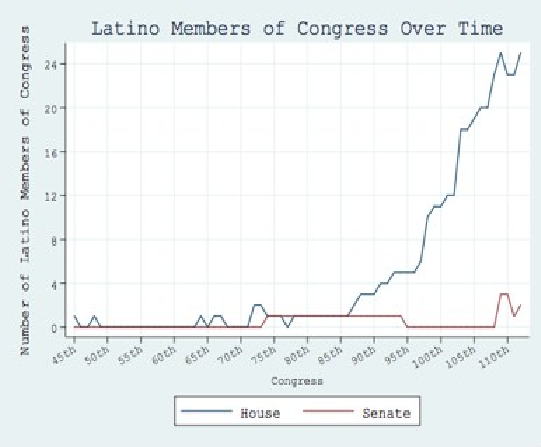A recent blog to the Latino Decisions page noted that Susana Martinez and Marco Rubio, both mentioned as possible Vice Presidential candidates, were largely unknown by Latino voters. While somewhat surprising, this seems to be in line with other surveys focused on Latino’s knowledge of Latino political leaders. For example, a 2010 poll by the Pew Hispanic Center asked 1,375 Latino adults to name the person they consider “the most important Latino leader in the country today”. A robust 64% of respondents said they “did not know”, and another ten percent of the sample responded that there “is none”. The most frequently cited Leader, at only 7%, was Supreme Court Justice Sonia Sotamayor.
This apparent lack of Latino political leadership comes after a period of unprecedented growth in political representation for Latinos. According to the National Association of Latino Elected Officials most recent directory of elected officials, the number of Latino elected officials increased by 53% from 3,734 in 1996 to 5,850 in 2011. This rise in Latino political representation appears to be apparent at all levels of public office. Specifically, the number of Latinos represented in Congress has more than doubled from 12 legislators in the 101st Congress (1989-1990) to a high of 28 Latino members of Congress in the 109th (2005-2006). This rise in Latinos in Congress is apparent in figure one below. Here you can see a steady climb in the number of Latinos within Congress over time, especially in the House, with a high of 28 in the 109th Congress. While the number of Latinos in Congress has dropped slightly over the past two election cycles, the 26 members serving in the 112th Congress is much greater than the 19 who served a decade ago.
This rise in Latino representation is even more apparent at the state level. Since the 1970’s the percentage of Latinos in state legislatures across the U.S. has increased steadily. For example, from 1996 to 2010 there has been a 57% increase in the percentage of Latinos elected to state legislatures, with 245 Latinos represented in state legislatures across the nation. And as noted above, two Latinos are currently serving as Governors of their state: New Mexico’s Susana Martinez and Nevada’s Brian Sandoval. Finally, the election of Antonio Villaraigosa as mayor of Los Angeles symbolizes similar representation trends at this level. Major cities such as Denver, San Antonio, and Miami have elected Latino mayors, as well as several smaller cities such as Albuquerque, Santa Fe, Austin and El Paso. At least one of these mayors, San Antonio’s Julian Castro, has received major national attention, referenced by the New York Times as the “Post-Hispanic Hispanic Politician”.
The rise in Latino representation in elected offices across all levels of government has definitely provided a strong and growing pool of potential national leaders. However, although there has clearly been a rise in Latino representation, the question remains as to whether Latinos, themselves, views these elected officials as leaders of their community. The results of the Pew survey appear to suggest that the diversity among Latinos in regard to partisanship, region, and nativity etc. may hinder their ability to rally around a national Latino leader. Although the Pew poll was conducted just prior to the election of Rubio and Martinez, the November, 2011 Latino Decisions poll provides the ability to explore this possibility.
The November poll reveals sizable differences in favorability for Marco Rubio based on partisanship, with 56% of Latino Republicans indicating that they have either “very” or “somewhat” favorable impressions of the Senator, compared to only 19% among Latino Democrats. There was a more modest 10% point gap based on nativity, with foreign-born Latinos having higher favorability for Rubio. U.S.-born and English dominant Latinos were less knowledgeable of both candidates. Native-born Latinos were 13% more likely to have “never heard of” New Mexico’s Martinez, and 15% more likely to have “never heard of” Florida’s Rubio. This is consistent with the Pew Report, which also found familiarity with Latino leaders to be greater among the foreign-born. Finally, and not surprisingly, both familiarity and favorability for Rubio and Martinez is greater in their respective regions of the country. For example, 23% of Latinos in the Southwest had favorable impressions of Martinez in the November poll, compared to only 8% in New York. Similarly, 44% of Latinos in Florida are favorable towards their home-Senator Rubio, compared to 25% in the Southwest and 19% in New York.
While it is clear that variation within the Latino population will continue to provide challenges to contenders for the title of “national Latino leader”, there are many reasons for optimism. The rise in Latino descriptive representation will provide a natural pool of candidates for higher office, including a potential Vice President in the near future. Further, as the influence of the Latino electorate continues to grow, both parties will be motivated to recruit and develop Latino leaders in an effort to court Latino voters. Finally, the rapid and unexpected rise of President Obama to national prominence provides an example of just how quickly a “national leader” can rise to prominence. In closing, let us not forget that at one point, Hillary Clinton had higher favorability and greater familiarity ratings among African Americans than Barack Obama.
Gabriel R. Sanchez is an Associate Professor of Political Science at the University of New Mexico and Research Director for Latino Decisions.



